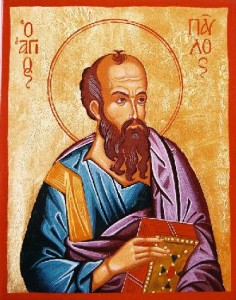 In running an apologetics site like this, I encounter all types. Recently, I encountered a new variety of heretic for whom I shall from now on refer to as the Anti-Paulist. This particular theological aberration purports to follow the teachings of Jesus while rejecting Paul… as if that were possible. In my recent encounter with aforementioned Anti-Paulist, he objected that Paul referred to the Gospel as his (Rom 2:16; 16:25; 2Tim 2:8). I must admit that does seem a bit unusual. Did the Gospel mystically belong to Paul? Was Paul’s Gospel unique in some way from that of the twelve? The answer is yes and no. Paul was uniquely chosen as the Lord’s theologian and evangelist to bring the message to the gentiles. In Paul, we find the best Pharisaic training in Torah tempered by a well-rounded education only available to a Roman citizen from a Hellenistic University town like Tarsus. Jesus chose Paul to reveal the mysteries of his relationship to the cosmic church.
In running an apologetics site like this, I encounter all types. Recently, I encountered a new variety of heretic for whom I shall from now on refer to as the Anti-Paulist. This particular theological aberration purports to follow the teachings of Jesus while rejecting Paul… as if that were possible. In my recent encounter with aforementioned Anti-Paulist, he objected that Paul referred to the Gospel as his (Rom 2:16; 16:25; 2Tim 2:8). I must admit that does seem a bit unusual. Did the Gospel mystically belong to Paul? Was Paul’s Gospel unique in some way from that of the twelve? The answer is yes and no. Paul was uniquely chosen as the Lord’s theologian and evangelist to bring the message to the gentiles. In Paul, we find the best Pharisaic training in Torah tempered by a well-rounded education only available to a Roman citizen from a Hellenistic University town like Tarsus. Jesus chose Paul to reveal the mysteries of his relationship to the cosmic church.
The Gospel defined in a creedal formula found in 1 Corinthians 15:3-7 describes Christ’s death, burial, resurrection and appearance to many eyewitnesses. Because 1 Corinthians is accurately dated to mid-fifties by archeological evidence, scholars are virtually unanimous that this is very early material dated to within the first few years of the actual events surrounding Jesus’ passion.[1] One of the arguments to support its early date is that Paul uses the Greek verb paralambano which is actually a rabbinic technical term for a received tradition.[2] Paul is reminding the Corinthians of what he first taught them. For Paul to have delivered to the Corinthians what he first received, then he must have received it prior to planting the Corinthian church on his second missionary journey (Acts 18:1). This firmly establishes the very early date for the creed.
“For I delivered to you as of first importance what I also received: that Christ died for our sins in accordance with the Scriptures, that he was buried, that he was raised on the third day in accordance with the Scriptures, and that he appeared to Cephas, then to the twelve. Then he appeared to more than five hundred brothers at one time, most of whom are still alive, though some have fallen asleep. Then he appeared to James, then to all the apostles. ” (1 Co 15:3–7)
Although he became a Christian as a result of his direct encounter with Jesus on the Damascus road (Gal. 1:12), he probably would not yet have known of all the eyewitnesses he refers to until he met with Peter and James (Gal. 1:18–24).[3] Peter and James were leaders of the church in Jerusalem and this passage from Galatians tells us he met with them for fifteen days albeit he did not meet any of the other apostles. Bruce makes note that the creed mentions these two specifically by name, thus evidencing its origin was likely from this meeting.[4] This creed has great apologetic force because one can establish that Jesus’ resurrection was not a product of legendary development over a long period of time as some skeptics have alleged.
It seems somewhat problematic that one can see clearly that Paul received this tradition yet in Galatians 1:12 Paul insists, “For I did not receive it from any man, nor was I taught it, but I received it through a revelation of Jesus Christ.” However, this is true in the sense that Paul was not converted by testimony rather a direct encounter with the risen Lord. Paul was radically changed by blatant supernatural intervention. Due to this, Paul’s Gospel is distinctive in his understanding of the Christian being “in Christ” and that the body of believers represents the “body of Christ.” Bruce points out that this is seen in Jesus question to Saul, “Why are you persecuting me?”[5] It is implicit in that question that the believers he was persecuting were “at one with” or “in Christ.” In this way, we see the equality and divine union of Christian fellowship, that “in Christ” believers share a mystical unification of sorts. For Paul the Gospel was far more than facts about the resurrection. It was the ultimate achievement for the redemption of all of creation (Rom 8:19-23).[6] Thus, the factual content he delivered to the Corinthians represents the received tradition and the more mysterious theological constructs represent the elements from revelation. Together they form Paul’s Gospel.
[1]Gary R. Habermas, The Historical Jesus : Ancient Evidence for the Life of Christ (Joplin, Mo.: College Press Pub. Co., 1996), 154.
[2] F. F. Bruce, Paul: Apostle of the Heart Set Free (Grand Rapids: Eerdmans Publishing Co., 1977), 87.
[3] Craig Blomberg, The NIV Application Commentary: 1 Corinthians (Grand Rapids, MI: Zondervan Publishing House, 1994), 295.
[4] Bruce, Paul, 85.
[5] Ibid, 87.
[6] Ibid, 93.



